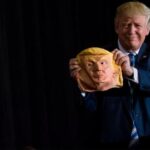
Understanding ‘Trump Wannabe Syndrome’: A Deep Dive into Trump’s Political Legacy
Tháng 4 8, 2025
British Pound versus US Dollar: A Comprehensive Hourly Forex Analysis – 09/04/2025
Tháng 4 8, 2025Trump’s Stance on Tariffs: A Stalwart Approach to Trade Negotiations
As the global economy continues to navigate the complexities of international trade, former President Donald Trump’s administration remains steadfast in its approach to tariffs. Despite fluctuating relations and significant geopolitical challenges, there are no immediate signs that Trump will relent on his rigorous tariff policies. This unwavering commitment plays a crucial role in his economic strategy, primarily aimed at safeguarding American industries and promoting fairer trade practices.
The Framework of Tariffs Under Trump’s Administration
In April 2025, the Trump administration invoked the International Emergency Economic Powers Act (IEEPA) to impose a variety of tariffs. Notably, a recent executive order established a sweeping 10% global tariff, accompanied by increased reciprocal tariffs aimed specifically at countries deemed engaged in unfair trading practices. This approach underscores a clear intention to address trade deficits while enforcing a sense of reciprocity in all trade engagements.
The administration’s strategy transcends mere economic measures; it represents a broader assertion of national security interests. At the foundation of this tariff policy is a desire to protect American workers and industries from external pressures and perceived unfair competition. This unwavering resolve reflects Trump’s long-held views regarding trade—asserting that the U.S. must prioritize its economic sovereignty and security above all.
Implications for Global Economic Relations
While the tariffs serve as a negotiating tool, their effects on diplomatic relations are multifaceted. Although there may not currently be a direct connection between tariffs and foreign aid, these economic policies undeniably influence broader geopolitical dialogues. Tariffs shape interactions with other nations and can complicate discussions surrounding aid and cooperation.
The nature of these tariffs introduces a possibility of straining existing relationships, compelling countries to reassess their trade strategies with the U.S. However, this outcome is more an indirect effect rather than a direct correlation to Trump’s tariff policies. The insistence on maintaining tariffs and strict trade conditions indicates that concessions from trade partners might be required to facilitate any progressive negotiations. Furthermore, global leaders, including China’s President Xi Jinping, have been compelled to address their positions regarding trade. For more insights on Xi’s strategic moves in this context, you can read about it here.
Conclusion: A Steel Wall of Tariffs
In summary, Trump’s inflexible stance on tariffs underscores a persistent commitment to his principles of trade reciprocity and economic security. The recent implementation of tariffs serves as a tactical measure to leverage negotiations, offering a clear warning to trade partners regarding the American administration’s expectations. Should there be any inclination to alter this course, it will undoubtedly necessitate substantial concessions from international counterparts.
As the global landscape continues to evolve, it is crucial to monitor the ongoing developments regarding Trump’s tariff policies and their potential ramifications on international relations and economic collaborations. With no end in sight for the current tariff structures, it remains essential for both political analysts and business leaders to stay informed about how these dynamics will ultimately unfold.

